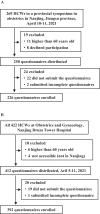COVID-19 vaccination coverage among healthcare workers in obstetrics and gynecology during the first three months of vaccination campaign: a cross-sectional study in Jiangsu province, China
- PMID: 34802373
- PMCID: PMC8903925
- DOI: 10.1080/21645515.2021.1997297
COVID-19 vaccination coverage among healthcare workers in obstetrics and gynecology during the first three months of vaccination campaign: a cross-sectional study in Jiangsu province, China
Abstract
Before the availability of COVID-19 vaccines, surveys showed that vaccine hesitancy may influence the acceptance of COVID-19 vaccination. In this cross-sectional study, we aimed to investigate COVID-19 vaccination coverage among healthcare workers (HCWs) in obstetrics and gynecology, during the first three-month period of the vaccination campaign after COVID-19 vaccines were approved. A total of 662 eligible HCWs, consisting of 250 HCWs (group one) who participated in a Jiangsu provincial symposium and 412 HCWs (group two) in the department of obstetrics and gynecology, Nanjing Drum Tower Hospital, were invited to answer a 23-question questionnaire. In total, 618 (93.4%) HCWs completed the questionnaire. The vaccine acceptance in group one was higher than that in group two (87.2% [197/226] vs 74.2% [291/392], χ2 = 14.436, P < .001). Overall, 488 (79.0%) HCWs received COVID-19 vaccination and 130 (21.0%) declined vaccination. One-third of the 488 vaccinees were not vaccinated until consulted with others or requested by employers. Adjusted logistic regression analysis showed that the decline of vaccination was associated with worry about the safety of the vaccine (OR 1.920, CI 95% 1.196-3.082; P = .007). The main reason for the decline of COVID-19 vaccination included the concern about vaccine safety, pregnancy preparation, pregnancy, or lactation. These results indicate that more safety data about COVID-19 vaccines, particularly in pregnant or lactating women, are required to promote the acceptance of COVID-19 vaccination. In addition, vaccination requests or mandates by employers may increase the acceptance of COVID-19 vaccines.
Keywords: COVID-19 vaccine; healthcare workers; obstetrics and gynecology; vaccine acceptance.
Conflict of interest statement
No potential conflict of interest was reported by the authors.
Figures
Similar articles
-
Real-World Acceptance of COVID-19 Vaccines among Healthcare Workers in Perinatal Medicine in China.Vaccines (Basel). 2021 Jun 27;9(7):704. doi: 10.3390/vaccines9070704. Vaccines (Basel). 2021. PMID: 34199143 Free PMC article.
-
Vaccination willingness, vaccine hesitancy, and estimated coverage of SARS-CoV-2 vaccine among healthcare workers in Tanzania: A call for action.Immun Inflamm Dis. 2023 Dec;11(12):e1126. doi: 10.1002/iid3.1126. Immun Inflamm Dis. 2023. PMID: 38156379 Free PMC article.
-
The impact of vaccine hesitancy on psychological impairment among healthcare workers in a Total Worker Health© approach.Front Public Health. 2024 Sep 12;12:1447334. doi: 10.3389/fpubh.2024.1447334. eCollection 2024. Front Public Health. 2024. PMID: 39328994 Free PMC article.
-
COVID-19 vaccination hesitancy in Italian healthcare workers: a systematic review and meta-analysis.Expert Rev Vaccines. 2022 Sep;21(9):1289-1300. doi: 10.1080/14760584.2022.2093723. Epub 2022 Jun 30. Expert Rev Vaccines. 2022. PMID: 35757890
-
COVID-19 vaccine hesitancy among healthcare workers in Arab Countries: A systematic review and meta-analysis.PLoS One. 2024 Jan 2;19(1):e0296432. doi: 10.1371/journal.pone.0296432. eCollection 2024. PLoS One. 2024. PMID: 38166119 Free PMC article.
Cited by
-
Reduced antibody response to COVID-19 vaccine composed of inactivated SARS-CoV-2 in diabetic individuals.Front Public Health. 2022 Dec 8;10:1025901. doi: 10.3389/fpubh.2022.1025901. eCollection 2022. Front Public Health. 2022. PMID: 36568756 Free PMC article.
-
Incidence of SARS-CoV-2 infection in children shortly after ending zero-COVID-19 policy in China on December 7, 2022: a cross-sectional, multicenter, seroepidemiological study.Front Public Health. 2023 Nov 9;11:1283158. doi: 10.3389/fpubh.2023.1283158. eCollection 2023. Front Public Health. 2023. PMID: 38026391 Free PMC article.
-
Healthcare Workers' Attitudes towards Mandatory COVID-19 Vaccination: A Systematic Review and Meta-Analysis.Vaccines (Basel). 2023 Apr 21;11(4):880. doi: 10.3390/vaccines11040880. Vaccines (Basel). 2023. PMID: 37112791 Free PMC article. Review.
-
Self-Reported adverse events among Chinese healthcare workers immunized with COVID-19 vaccines composed of inactivated SARS-CoV-2.Hum Vaccin Immunother. 2022 Nov 30;18(5):2064134. doi: 10.1080/21645515.2022.2064134. Epub 2022 Apr 22. Hum Vaccin Immunother. 2022. PMID: 35452357 Free PMC article.
-
High SARS-CoV-2 infection rate in children unvaccinated with COVID-19 vaccine in Changzhou, China, shortly after lifting zero-COVID-19 policy in December 2022.BMC Infect Dis. 2024 Jun 5;24(1):560. doi: 10.1186/s12879-024-09445-3. BMC Infect Dis. 2024. PMID: 38840046 Free PMC article.
References
-
- World Health Organization . COVID-19 weekly epidemiological update edition 58. Published 2021. Sep 21 [accessed 2021 Sep 22]. https://www.who.int/publications/m/item/weekly-epidemiological-update-on....
-
- Voysey M, Clemens SAC, Madhi SA, Weckx LY, Folegatti PM, Aley PK, Angus B, Baillie VL, Barnabas SL, Bhorat QE, et al. Safety and efficacy of the ChAdOx1 nCoV-19 vaccine (AZD1222) against SARS-CoV-2: an interim analysis of four randomised controlled trials in Brazil, South Africa, and the UK. Lancet. 2021;397(10269):99–111. doi:10.1016/S0140-6736(20)32661-1. - DOI - PMC - PubMed
Publication types
MeSH terms
Substances
LinkOut - more resources
Full Text Sources
Medical

